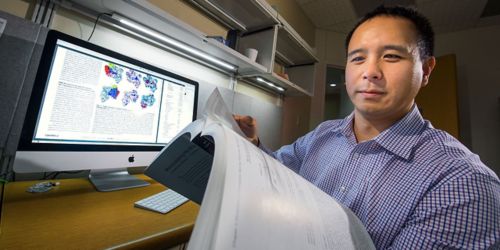St. Jude Family of Websites
Explore our cutting edge research, world-class patient care, career opportunities and more.
St. Jude Children's Research Hospital Home

- Fundraising
St. Jude Family of Websites
Explore our cutting edge research, world-class patient care, career opportunities and more.
St. Jude Children's Research Hospital Home

- Fundraising
What hidden hazards lie beneath the surface of genome editing?

Shengdar Tsai, PhD, works to uncover the hidden dangers of gene editing.
The human genome, our complete set of DNA, contains about 3 billion base pairs within 23 chromosomes. In 2003, scientists completed a project to sequence the human genome. Yet, scientists still don’t fully understand the roles of the estimated 22,000 genes and other sequences within those 23 chromosomes.
“Even though we now have the human genome sequence, our ability to interpret its function is still limited. It’s like having the full text of a book where you don’t know what many words mean,” says Shengdar Tsai, PhD, of St. Jude Children’s Research Hospital.
Why is it crucial to understand that information?
Well, many human diseases — including life-threatening disorders like childhood cancer — arise from mutations, or changes, to the body’s DNA.
A nautical map
Through genome-editing technology, scientists like Tsai can directly change the DNA of living cells. Genome editors are like tiny molecular scissors that can be programmed to cut precise locations in the genome. As cells naturally repair these cuts, DNA at these spots can be added, deleted, replaced, or, in other words, edited.
“Genome-editing technologies are amazing because they can enable curative therapies, where a patient’s own cells are permanently genetically changed to treat the disease,” Tsai says.
If proven to be safe and effective, genome-editing technologies may soon deliver cures for pediatric cancer, HIV, sickle cell disease and many other diseases.
But these scientific breakthroughs depend on a deeper understanding of the ‘global’ effects of genome editing.
Tsai, who enjoys sailing, came to the St. Jude Hematology Department from Boston. He likens scientists’ current understanding of genome-editing effects to an incomplete nautical map. Scientists can see locations of potential hazards, but their depth and danger remain unknown.
A pioneer in understanding genome-editing technologies, Tsai is developing tools to make better maps.
Setting sail
Many headlines in recent years convey the same point: “New genome-editing technique transforms human medicine.”
In fact, genome editing today has been remarkably simplified. The editing technology that has garnered this attention and excitement is called Clustered Regularly Interspaced Palindromic Repeats — or CRISPR-Cas9. “Cas9” refers to an enzyme that can be easily programmed to cut DNA at specific locations.
CRISPR is a powerful tool.
“Any gene you’re interested in, you can mutate in a cell and study the effects of that mutation quickly,” says Mitch Weiss, MD, PhD, St. Jude Hematology chair. “But to do something clinically,” he adds, “is much more difficult because there are lots of things you have to worry about.”
A sharp lookout
One of the things Weiss, Tsai and other scientists worry about is malignant cell transformation. During gene editing, some cells might experience accidental cuts in their DNA and mutations may result in unwanted cell growth.
“For any genome-editing target, we wanted the capability to ask, ‘What areas of the genome are we really changing?’” Tsai explains.
Tsai recalls early work in his field using computational predictions to find the location of unintended, off-target mutations. It was a guessing game, like losing your keys in the dark and looking for them only where it’s well-lit.
To search completely, Tsai developed sensitive and unbiased experimental tests. One of these methods — Genome-wide Unbiased Identification of Double-stranded breaks Enabled by Sequencing (GUIDE-seq) — has been adopted by many large companies and institutions as the go-to method for defining genome-editing activity across the human genome for clinical applications.
Wide berth
Still, a daunting challenge remains: making a map that enables scientists to know the depth of the dangers below, the functional effects of unintended off-target mutations.
“What we need to do is see beneath the surface,” Tsai explains.
New methods under development in his lab will help scientists detect possible adverse effects related to genome-editing, speeding the development of safe, effective therapies.
Tsai was recently awarded an NIH grant from the Somatic Cell Genome Editing program, a National Institutes of Health Common Fund program designed to improve methods for editing the human genome.
The grant will support development of a new way to test the safety of genome editors with human T cells. Scientists commonly use T cells to develop genome editing therapies for cancer and other diseases.
“T cells are unique cells, in that they rearrange their DNA to produce genetic diversity for adaptive immune recognition,” Tsai says. “Each cell’s genomic rearrangements can be a cellular barcode we can use to identify potential threats. For us, T cells are like the canary in the coal mine to identify genome-editing–associated dangers.”
All hands on deck
Tsai and his team have developed new tools to perform rapid large-scale testing of genome editors. Immense datasets are required to navigate the depths of the genome and accurately predict activity using cutting-edge deep learning and artificial-intelligence technology.
“Now we can look at a large number of targets to learn important principles about genome-editing safety,” says Tsai, explaining his excitement about the promise of his research.
While these studies progress, Weiss and Tsai are developing a CRISPR gene-editing effort to translate lab results to clinical care — and perhaps, one day soon, cures. Joining forces with St. Jude hematologist-oncologist Akshay Sharma, MBBS, and Shondra Pruett-Miller, PhD, Center for Advanced Genome Engineering director, their team uses CRISPR-Cas9 to edit blood stem cells to induce fetal hemoglobin, a possible cure for sickle cell disease and other blood disorders.
“Genome editing is an amazing technology that has changed the way we work in the lab,” Weiss says. “It will eventually change patient care as well.”
Tsai and his colleagues from St. Jude, the National Institute of Standards and Technology, and Carnegie Mellon University hope their work will ultimately help scientists safely navigate the vast unknown territories of clinical genome-editing.






